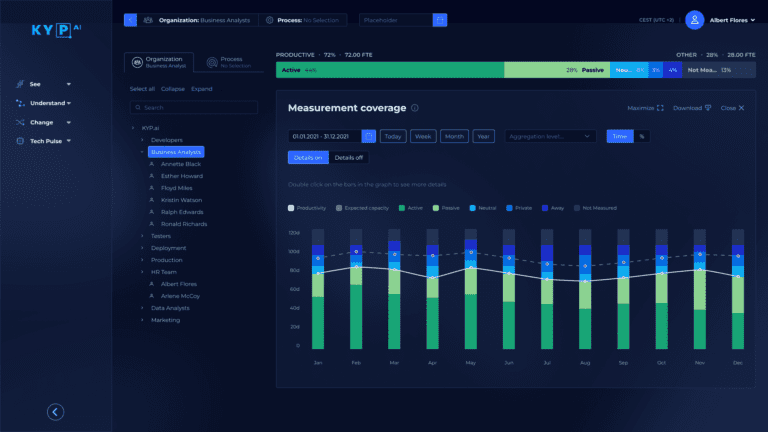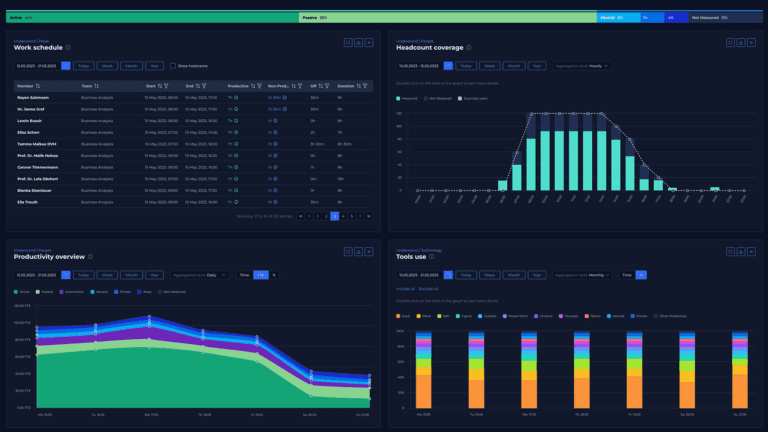Companies are under continuous pressure to adapt and improve how they work. Agility and efficiency are essential for staying competitive. Businesses focusing on these areas are more likely to pull ahead of the competition.
But real agility takes more than just rolling out new tools for automating tasks. It begins with a clear understanding of how work is done and the ability to make data-driven decisions without system delays. That’s where business process transformation comes in. It is a practical and scalable strategy to drive meaningful change, especially when paired with intelligent, real-time monitoring.
KYP.ai helps make this possible by adding an intelligence layer that makes sense of digital behavior. It gives teams the visibility to understand what’s working, the insights to improve it, and the tools to track progress, ensuring every change supports broader business goals and delivers real results.
What is Business Process Transformation?
Business process transformation refers to the strategic redesign and optimization of core business operations to achieve improved outcomes. Most businesses identify both incremental improvements and fundamental changes that drive significant increases in performance, efficiency, and value delivery.
Organizations typically pursue business transformation to align their processes. Typically, using new technologies, they aim to improve customer experiences, reduce costs, adapt to evolving market conditions, and more.
Key Challenges
Despite its benefits, transformation initiatives can be complex and difficult to manage. Common challenges include:
- Lack of visibility into how processes are executed
- Misalignment between technology upgrades and operational workflows
- Fragmented data and disconnected systems
- Employee resistance to change
- Limited ability to measure outcomes in real time
Example
Consider a financial services company that decides to digitize its customer onboarding process. On the surface, automation successfully reduces manual data entry and speeds up initial steps. However, delays soon emerge during the identity verification stage due to inefficient internal handoffs between departments. These delays weren’t anticipated during the planning phase. Because the company lacks real-time visibility into how the process is actually executed, the root cause of the issue remains hidden. As a result, the organization struggles to fully realize the benefits of its digital transformation – such as faster onboarding times and improved customer satisfaction.
This example highlights the importance of combining automation with process intelligence and real-time monitoring to find and fix hidden inefficiencies.
The Three Core Phases of Business Process Transformation
Effective transformation is typically structured into three key phases: Analyze, Stabilize, Optimize, and Monitor. Each phase builds on the previous one, ensuring improvements are based on real data and delivering measurable results.
1. Analyze
The first phase involves identifying inefficiencies, bottlenecks, and pain points. This requires accurate data collection, process discovery, and mapping.
With solutions like KYP.ai, organizations can automatically capture data from systems and user interactions without disrupting workflows. This enables teams to compare assumed processes with actual execution and leverage AI to identify performance gaps, establishing a factual baseline for improvement.
2. Revamp
Once the analysis is complete, the next step is redesigning workflows to address inefficiencies. This may involve automating repetitive tasks, removing unnecessary steps or redundancies, realigning roles and responsibilities, and improving team collaboration and handoffs. By leveraging the insights gained during the analysis phase, organizations can ensure that these changes are targeted, effective, and aligned with overall business objectives.
3. Optimize
Continuous monitoring is critical for sustaining transformational outcomes. By implementing real-time data tracking, organizations can assess process performance, identify emerging issues, and make timely adjustments.
Monitoring also provides feedback to scale successful initiatives and adapt strategies based on real-world results. With platforms like KYP.ai, businesses can access ongoing performance metrics and insights that support continuous improvement.
A Step-by-Step Approach to Business Process Transformation
To execute a successful transformation strategy, organizations should follow a structured approach:
1. Conduct Process Analysis
Begin by using KYP.ai to capture data across applications and workflows unintrusively. This helps identify how work is performed, revealing inefficiencies that are often hidden.
2. Define Goals and KPIs
Set clear, measurable goals aligned with business outcomes. Examples include reducing process cycle time, improving quality, or lowering operational costs. Define relevant KPIs that will track progress and success throughout the initiative.
3. Engage Stakeholders
Transformation requires input and collaboration across departments. Involving stakeholders early helps build alignment, surface operational knowledge, and create buy-in for upcoming changes.
4. Redesign Workflows
Using the insights from earlier steps, redesign processes to be more efficient and goal-driven. Ensure that all changes align with business strategy and contribute to improved outcomes.
5. Test and Simulate
Before full-scale implementation, test redesigned processes in a controlled environment. Simulations help identify gaps or risks and allow teams to adjust before going live.
6. Implement New Processes
Roll out the new workflows with proper documentation and training. Ensure teams are equipped to adopt changes smoothly and provide support during the transition.
7. Monitor and Iterate
After implementation, continue monitoring performance using KYP.ai. Real-time dashboards and reports help track KPIs, uncover new issues, and support ongoing refinement.
When to Apply Business Process Transformation
Business process transformation becomes essential when certain warning signs appear across operations. Recognizing these early can help organizations address inefficiencies before they escalate. Common signs include:
- Frequent process errors or delays
Recurring mistakes, missed deadlines, or workflow bottlenecks often signal that existing processes are outdated or overly complex. These issues not only impact productivity but can also erode trust with customers and stakeholders over time.
- Post-technology upgrade misalignment
Investing in new technology doesn’t always translate to improved performance. When upgrades fail to deliver expected results, it often indicates a disconnect between the tools implemented and the business needs or processes they’re meant to support. Transformation helps align technology with operational goals.
- High resource consumption with low output
When teams expend significant time, effort, or budget with minimal returns, it shows that processes are inefficient. This imbalance drains resources and limits scalability, making it critical to reassess how work is done and where improvements can be made.
- Poor customer or employee experience
A growing number of customer complaints or declining employee morale can reflect process-related frustrations. Whether it’s long response times, inconsistent service, or cumbersome internal workflows, these issues highlight the need for a more streamlined, user-focused approach to business operations.
Measuring Success in Business Process Transformation

Organizations must measure success using clear, relevant metrics to ensure that transformation efforts deliver value. These typically include:
1. Customer Satisfaction
Improved customer experience is often a key goal. Monitor the impact of satisfaction scores, Net Promoter Score (NPS), and service response times.
2. Operational Efficiency
Track reductions in process cycle times, error rates, and rework. These indicators reveal how much more efficiently teams are working after transformation.
3. Cost and ROI
Calculate cost savings generated from automation, reduced labor hours, or improved resource utilization. Comparing these savings with the investment helps quantify ROI.
4. Employee Productivity
Evaluate how employees are spending their time post-transformation. Improved processes often allow teams to focus on higher-value work, leading to increased output.
5. Real-Time Performance Monitoring
With KYP.ai, performance data is available continuously, not just in periodic reports. This enables faster decision-making and more agile operations.
Conclusion
Intelligence is not just a part of transformation; it is its foundation. Transformation efforts often fall short without a clear understanding of how work is performed and how it aligns with business goals. When combined with continuous monitoring and real-time intelligence, business process transformation becomes sustainable and outcome-driven, evolving from simple change into a strategic initiative that improves how work gets done across the organization.KYP.ai enables this transformation by providing the visibility, insights, and tools needed to optimize operations effectively. It helps organizations precisely understand current performance, identify high-impact improvement opportunities, and monitor results in real time. By embedding intelligence into every transformation phase, businesses can make smarter decisions and drive lasting impact.
FAQs
What makes process intelligence essential in business process transformation?
Process intelligence enables organizations to understand how operations are performed. It provides data-driven insights that guide improvements and reduce risk during transformation.
How does KYP.ai differ from traditional BPM tools?
Traditional BPM tools focus on mapping ideal workflows. KYP.ai captures real-time execution data, offering a factual view of process behavior. It also exports findings in BPM-ready formats for further modeling and implementation.
Can KYP.ai work with our existing legacy systems?
Yes. KYP.ai integrates with existing systems and captures data without disrupting operations. It supports both modern and legacy environments, making it suitable for a wide range of organizations.
How quickly can we expect to see results with KYP.ai?
Organizations often begin to see actionable insights within the first few weeks. Tangible improvements such as cost savings or efficiency gains typically follow within one to three months, depending on the initiative’s scope.
Is KYP.ai only designed for large enterprises?
While it supports complex enterprise environments, KYP.ai is equally valuable for mid-sized businesses looking to optimize processes and drive transformation.
Discover Your Productivity Potential – Book a Demo Today
Book Demo








